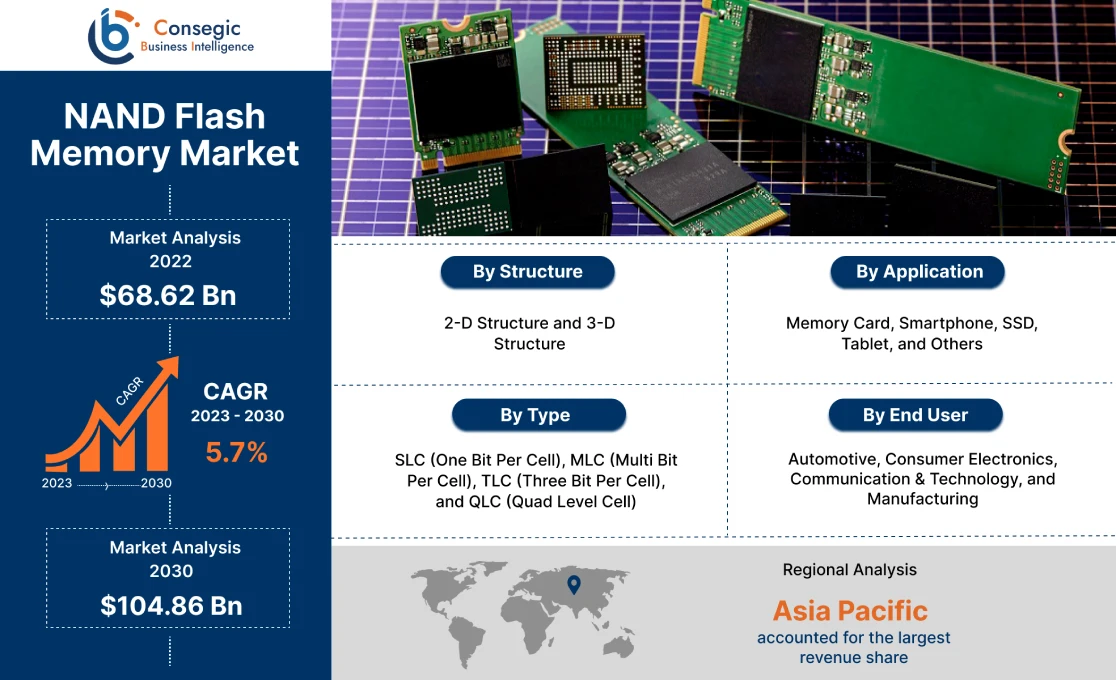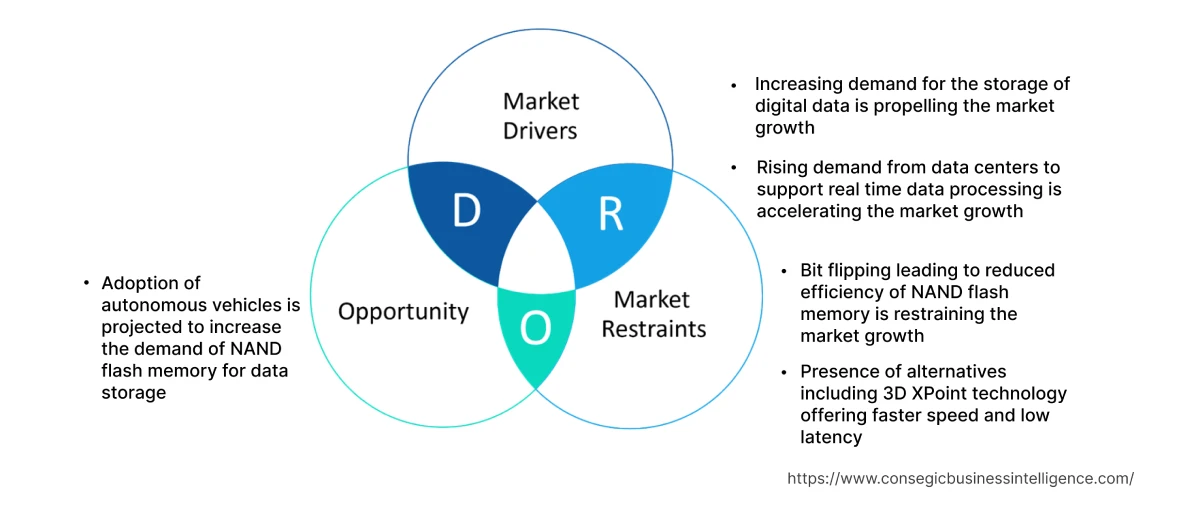NAND Flash Memory Market Size :
Global NAND Flash Memory Market size is estimated to reach over USD 104.86 Billion by 2030 from a value of USD 68.62 Billion in 2022, growing at a CAGR of 5.7% from 2023 to 2030.
NAND Flash Memory Market Scope & Overview:
NAND flash memory is defined as a type of non-volatile memory technology installed in electronic devices that are capable of storing data in the absence of a power supply. It was developed to increase maximum chip capacity and to reduce the cost per bit. Additionally, flash memory is widely utilized in consumer electronics devices namely smartphones, tablets, USB drives, solid-state drives (SSDs), and memory cards.
NAND Flash Memory Market Insights :
NAND Flash Memory Market Dynamics - (DRO) :
Key Drivers :
Increasing demand for the storage of digital data.
The growing volume of digital data including high-definition videos, photos, music, and documents increases the demand for advanced solutions for the storage of data. NAND flash memory provides high-capacity storage solutions to accommodate the growing volume of data, thus contributing significantly to driving the growth of the market. Analysis of market trends concludes that the prevalent use of flash memory is also driven by consumer electronics devices including smartphones, tablets, digital cameras, and portable media players. The devices require sufficient storage for operating systems, applications, media files, and user data, further increasing the NAND flash memory market demand. For instance, in December 2020, TDK Corporation launched a new generation of storage products with NAND flash memory control IC for the storage of security applications. The flash solutions have a storage capacity of over 1 TB and an anti-spoofing security feature to prevent the leakage of data.
Rising demand from data centers to support real-time data processing.
Data centers are the backbone of modern computing infrastructure, handling vast amounts of data and supporting various applications and services. Analysis of market trends concludes that the data centers are responsible for providing real-time data processing at low latency rates and faster speeds which raises the demand for advanced NAND flash memory solutions. Flash memory, particularly solid-state drives (SSDs), offers advantages over traditional hard disk drives (HDDs) to provide improved performance and power efficiency required for multiple applications including efficient database management, content delivery, and real-time analytics. For instance, in May 2023, Micron Technology, Inc. launched the Micron XTR NVMe SSD and the Micron 6500 ION NVMe SSD for data centers to lower operational costs and improve operational storage capacity. The SSD offers 34% average read latency to enhance the performance in real-time analytics, thus contributing significantly to driving the NAND flash memory market growth.
Key Restraints :
Bit flipping leads to the product's reduced efficiency.
Bit flipping, also termed as bit errors or read disturbs, is a phenomenon that occurs in NAND flash memory leading to data corruption and affecting the integrity of stored information. Bit flipping leads to the wear and tear of the flash memory cells, as the cells are prone to degradation, leading to reduced endurance and lifespan. Moreover, bit errors negatively impact the accuracy and consistency of stored data, particularly in critical applications including enterprise storage systems and databases, thus impeding the growth of the global market.
Presence of alternatives including 3D XPoint technology offering faster speed and low latency.
The presence of alternative technologies including 3D XPoint provides faster speed and low latency as compared to traditional NAND flash memory is restraining the growth of the market. Additionally, 3D XPoint technology offers near-DRAM (Dynamic Random Access Memory) that allows faster data access nearly 1000 times faster and processing coupled with superior endurance, thus limiting the adoption of flash memory. Moreover, 3D XPoint technology allows data to be accessed and modified at the individual bit level, offering greater flexibility and granularity, thus impeding the proliferation of the NAND flash memory market.
Future Opportunities :
Adoption of autonomous vehicles.
Autonomous vehicles generate vast amounts of data from various sensors, cameras, and communication systems. The data includes high-resolution video feeds, sensor readings, mapping information, and telemetry data. NAND flash memory's high-capacity storage capabilities and fast data access are ideal for storing and processing data in real time. Additionally, autonomous vehicles extensively log data to analyze driving patterns, improve performance, and enhance safety measures. The flash memory provides the necessary storage capacity and reliability for capturing and storing data, thus creating potential NAND flash memory market opportunities for the proliferation of the market in the upcoming years.
NAND Flash Memory Market Report Insights :
| Report Attributes | Report Details |
| Study Timeline | 2017-2030 |
| Market Size in 2030 | USD 104.86 Billion |
| CAGR (2023-2030) | 5.7% |
| By Type | SLC (One Bit Per Cell), MLC (Multi Bit Per Cell), TLC (Three Bit Per Cell), and QLC (Quad Level Cell) |
| By Structure | 2-D Structure and 3-D Structure |
| By Application | Memory Card, Smartphone, SSD, Tablet, and Others |
| By End-User | Automotive, Consumer Electronics, Communication & Technology, and Manufacturing |
| By Region | Asia-Pacific, Europe, North America, Latin America, Middle East & Africa |
| Key Players | ATP Electronics, Inc., Intel Corporation, KIOXIA Corporation, Micron Technology Inc., Powerchip Semiconductor Manufacturing Corp., Renesas Electronics Corporation, Samsung Electronics Co. Ltd., SK Hynix Inc., Western Digital Corporation |
NAND Flash Memory Market Segmental Analysis :
By Type :
The type segment is classified into SLC (One Bit Per Cell), MLC (Multi Bit Per Cell), TLC (Three Bit Per Cell), and QLC (Quad Level Cell). Three bits per cell accounted for the largest market share of 32.09% in 2022 as TLC NAND offers higher storage density by storing three bits of data per memory cell instead of two. The increased storage density allows for more data to be stored in physical space, resulting in a lower cost per gigabyte of storage. In addition, manufacturers are implementing various techniques, including improved error correction codes (ECC), wear leveling algorithms, and advanced controller designs to enhance the endurance and reliability of TLC NAND. Analysis of market trends concludes that the increasing adoption of TLC in consumer electronics including smartphones, tablets, and solid-state drives (SSDs) is also contributing notably to accelerating the proliferation of the market.
QLC (Quad Level Cell) is expected to register the fastest CAGR during the forecast period as QLC NAND allows for the storage of four bits of data per memory cell, compared to three bits in TLC NAND. Analysis of market trends concludes that the improvements in cell design of QLC NAND including the integration of nitride-based charge trap (NBCT) and silicon nitride (SiN) that enables precise control over the storage are also contributing to the market expansion. The advancements help to improve the accuracy and reliability of data storage, reducing the potential for errors and read disturbances. For instance, in January 2022, Kioxia Corporation launched UFS Ver. 3.1 embedded flash memory devices by utilizing 4-bit per cell quad-level-cell technology. The product is equipped with advanced technology to meet the high-density requirements of mobile applications, thus contributing to propelling the market proliferation in the upcoming years.
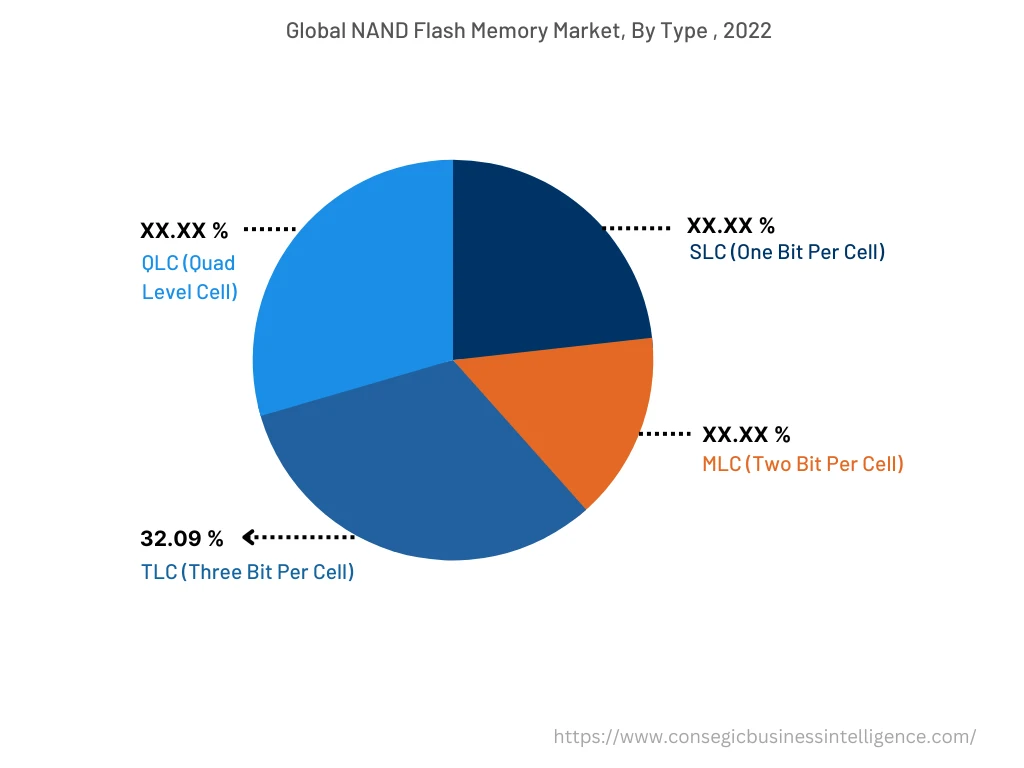
By Structure :
The structure component is bifurcated into 2-D Structure and 3-D Structure. In 2022, the 3D structure segment accounted for the highest NAND flash memory market share and is also projected to witness the fastest CAGR during the forecast period. The proliferation of the market is attributed to the ability of 3D structured NAND to offer improved performance compared to 2D NAND. The vertical stacking of memory cells in a 3D structure reduces the footprint leading to shorter interconnect distances and resulting in faster data transfer speeds, lower power consumption, and reduced latencies. Additionally, 3D structures aid in shortening the data processing time and increasing the speed, lifespan, and endurance of the flash memory. Assessment of market trends indicates that 3D structures NAND flashes, particularly SSDs are capable of working at extreme temperature ranges and can withstand harsh industrial conditions, hence contributing considerably to bolstering the market expansion. For instance, in May 2022, Transcend Information, Inc. introduced industrial-grade 112-layer 3D NAND SSDs to improve the speed, lifespan, and endurance of memory flashes. SSDs are capable of functioning at a temperature range of 20°C-75°C ensuring higher reliability and data integrity.
By Application :
The application segment is categorized into memory cards, smartphones, SSDs, tablets, and others. The smartphone accounted for the largest market share in 2022 as it offers faster sequential writeup and improved performance to download 4K movies. In addition, NAND also provides design flexibility and low power consumption enabling a more responsive mobile experience with multitasking across apps. Moreover, flash memory is employed for caching purposes to improve system performance for faster access, reducing load times, and enhancing user experience. Consequently, the aforementioned factors are collectively responsible for increasing the demand for flash memory in smartphones to enhance speed and performance. For instance, in July 2021, Micron Technology, Inc. launched 176-layer NAND flash storage in a mobile solution. The advanced NAND storage increases the speed by up to 75% enabling the download of 4K movies in 9.6 seconds at low power consumption.
Memory cards are anticipated to witness the fastest CAGR during the forecast period. Memory cards, including Secure Digital (SD) cards, are employed in digital cameras to store photos and videos. Memory cards offer a high capacity to capture and store several high-resolution images and videos without compromising the quality. Additionally, the flash memory enables smooth video recording and playback, ensuring that users capture and store high-quality videos without buffering. Assessment of market trends indicates that the ability of NAND flash in memory cards to provide portable and high-capacity storage solutions is expected to drive NAND flash memory market growth in upcoming years.
By End User :
The end-user segment is divided into automotive, consumer electronics, communication & technology, and manufacturing. Consumer electronics accounted for the largest market share in 2022 as flash memory is extensively employed in a wide range of consumer electronics devices including smartphones, tablets, and media players. Analysis of NAND flash memory market trends concludes that the increasing adoption of consumer electronics to provide non-volatile storage, high data transfer rates, and low power consumption is accelerating market expansion. Moreover, NAND flash offers improved speed and data processing capabilities including high-resolution images and high-capacity mobile games, further boosting the proliferation of the market. For instance, in April 2022, Samsung Electronics launched a Universal Flash Storage (UFS) 4.0 solution for 5G smartphones to improve the data processing capabilities. The launch of the 7th-generation V-NAND increases the read speed by 4,200 megabytes per second (MB/s) and sequential write speed of 2,800 MB/s, to deliver approximately 2x and 1.6x faster speeds over the previous UFS 3.1 product, respectively.
The automotive industry is projected to witness the fastest CAGR during the forecast period as flash memory is utilized in onboard navigation systems to store digital maps, points of interest (POI) databases, and route guidance data. The flash memory enables real-time navigation with fast map rendering and quick search capabilities, enhancing the user experience. In addition, flash memory is deployed in telematics systems to provide connectivity and communication capabilities in vehicles. Analysis of NAND flash memory market trends concludes that its application in instrument clusters and HUDs to store and display vehicle information, including speed, fuel level, engine status, and warnings, further driving the proliferation of the market.
By Region :
The regional segment includes North America, Europe, Asia Pacific, Middle East and Africa, and Latin America.
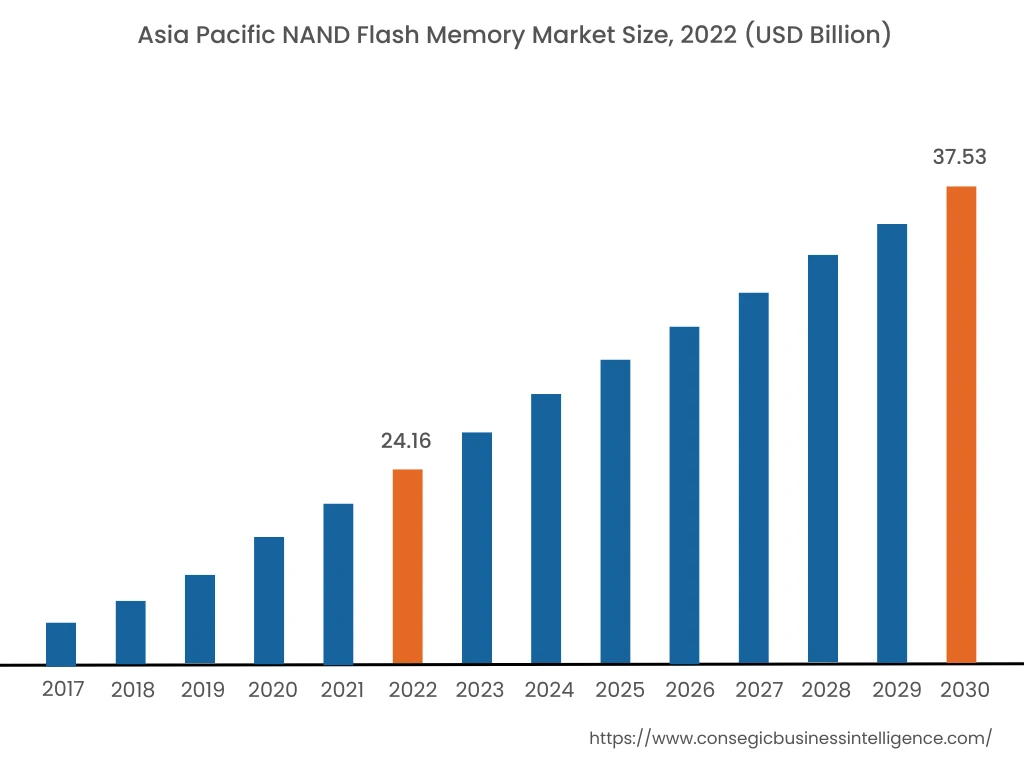
Asia Pacific accounted for the largest revenue share in the year 2022 valued at USD 24.16 Billion and is projected to grow at a CAGR of 5.9% accounting for USD 37.53 Billion in 2030. In addition, in the region, China accounted for the maximum revenue share of 26.3% in the year 2022. The NAND flash memory market analysis concluded that the expansion of the market is attributed to the expanding consumer electronics industry raising the demand for advanced flash memory to improve the speed and storage of various electronic devices including smartphones and tablets. Moreover, the presence of key players in the region including Samsung Electronics, SK Hynix, and Toshiba Memory are investing heavily and constantly applying innovations to strengthen the market position. For instance, in February 2021, SK Hynix completed the construction of an M16 plant to expand the semiconductor memory sector in South Korea. The increasing investment by key players to expand the semiconductor industry contributes significantly to accelerating the market proliferation in the region.
North America is anticipated to witness the fastest CAGR during the forecast period in the NAND flash memory market. The growth is attributed to the advancements in technology including cloud computing and the presence of data centers. The flash memory is widely employed in cloud computing applications owing to the high-speed data access, reliability, and storage capacity. In addition, the presence of key players including Intel, Micron Technology, Western Digital, and Texas Instruments has established a strong foothold in the market, driving innovation, research and development, and manufacturing of flash memory products. In conclusion, the emergence of advanced technologies and the presence of key players are collectively responsible for promoting market expansion in North America in the upcoming years.
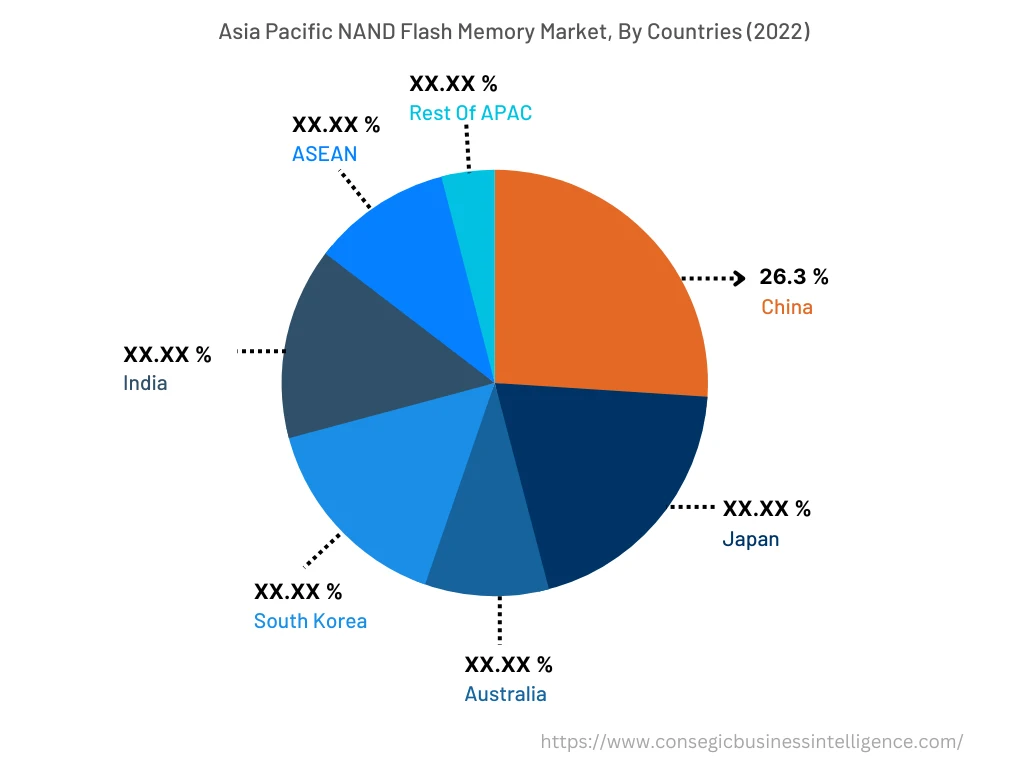
Top Key Players & Market Share Insights:
The competitive landscape of the NAND flash memory market has been analyzed in the report, along with the detailed profiles of the major companies operating in the NAND flash memory industry. Further, the surge in Research and Development (R&D), product innovation, various business strategies, and application launches have accelerated the growth of the NAND flash memory market. Key players in the NAND flash memory Market include-
- ATP Electronics, Inc.
- ADATA Technology Co., Ltd.
- Intel Corporation
- KIOXIA Corporation
- Micron Technology Inc.
- Powerchip Semiconductor Manufacturing Corp.
- renesas corporation electronics
- Samsung Electronics Co. Ltd.
- SK Hynix Inc.
- Moog
- Western Digital Corporation
Recent Industry Developments :
- In July 2021, ADATA Technology launched 112-layer stacked BiCS5 3D NAND SSDs to assist the development of 5G, Internet of Things (IoT), Artificial Intelligence (AI), Netcom, and server. 3D NAND technology is employed to offer durability, reliability, stability, and efficient storage of products to handle the processing of larger volumes of data at higher speeds.
- In June 2021, Micron Technology unveiled 176-Layer NAND and 1-Alpha DRAM to deliver data-driven insights for automotive applications. The advanced flash memory and dynamic random access memory (DRAM) chips are designed to deal with the bottleneck to feed data between storage, memory, and processing solutions.
Key Questions Answered in the Report
What is NAND Flash Memory? +
NAND flash memory is defined as a type of non-volatile memory technology installed in electronic devices that do not require power for data storage.
What specific segmentation details are covered in the NAND flash memory market report, and how is the dominating segment impacting the market growth? +
The report consists of segments including type, structure, application, end-user, and region. Each segment has a key dominating sub-segment being driven by industry trends and market dynamics. For instance, the type segment has witnessed TLC as the dominating segment in the year 2022. The growth is attributed to the increased storage density that allows data to be stored in the physical space, resulting in a lower cost per gigabyte of storage.
What specific segmentation details are covered in the NAND flash memory market report, and how is the fastest segment anticipated to impact the market growth? +
The report consists of segments including type, structure, application, end-user, and region. Each segment is projected to have the fastest-growing sub-segment fuelled by industry trends and drivers. For instance, in the application segment, the memory card is anticipated to witness the fastest CAGR growth during the forecast period. The growth is attributed to the ability of NAND flash in memory cards to offer a high capacity to capture and store several high-resolution images and videos without compromising the quality.
What specific segmentation details are covered in the NAND flash memory market report, and how does each dominating segment is influencing the demand globally? +
As aforementioned, each dominating segment is influencing the demand globally due to growing industrial needs. Moreover, fluctuation in demand being witnessed from different sectors is responsible for driving the NAND flash memory market.
